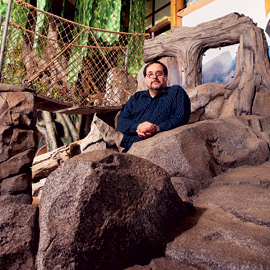Creating Brain-Friendly Spaces
SPU ’s John Medina
is on a mission to
apply brain science
to the “real world”
ACCORDING TO A RECENT U.S. Census
Bureau report, Seattle is now the brainiest
city in America. How fitting, then, that in his
Seattle Pacific University office a leading
developmental molecular biologist spends
his time thinking about how brains process
information. With a doctorate in eukaryotic
molecular biology, John Medina is director
of Seattle Pacific’s Brain Center for Applied
Learning Research.

John Medina poses on
“Summit Ridge,” one of
Zoomazium’s interactive,
nature-themed play
spaces that foster
learning through wholebody
exploration.
|
 |
Anyone who has heard Medina speak —
he’s a frequent national commentator for
radio and television, and has addressed
such diverse groups as state legislatures,
school boards, and psychiatrist conventions
— knows that his cranium encloses grey
matter that processes at frequencies the
rest of us can only imagine.
What is also remarkable about Medina is
his compassion: The man has a heart as
big as his brain. So it is not surprising that
he has forged improbable partnerships and
launched unconventional projects solely
for the purpose of making the world more
“brain-friendly” for some of our most
vulnerable humans — including kids and
combat pilots.
One such project is Zoomazium, a first-of-
its-kind, indoor, nature-themed play space
at Seattle’s Woodland Park Zoo. Divided into
several interactive “discovery zones,”
Zoomazium helps young children take learning
into their own hands by encouraging
problem-solving and whole-body exploration.
Once inside the facility, children can
climb a mountain, crawl into a “frog log,”
hatch out of a giant egg, scale a fig tree,
or explore a dark cave. They can see wild
animals in exhibits that mimic native habitats,
play interactive learning games, and
earn points for knowing nature facts or making
observations. Zoomazium’s design grew
out of a series of conversations between
Medina and Woodland Park Zoo Program
Manager Frank Hein about what a brain-friendly
kid space might look like.
“John and I really connected on this
project,” says Hein. “The deeper we dug
into how children actually learn, the more
the exhibit came together. The fact that
Zoomazium is so different from traditional
children’s play spaces and yet is so successful
speaks volumes for the real-world application
of John’s work.”
With characteristic modesty, Medina shifts
the credit to Hein. “Frank is the real hero,”
he says. “He has a true heart for kids, and
a deep and abiding interest in the biology of
learning. He came up with brilliant designs to flesh out what we had talked about.”
Two thousand miles away, a very different
sort of project has begun to take shape. At
the Boeing Leadership Center in St. Louis,
Missouri, Medina has held training sessions
out of which have emerged informal conversations
with current and retired Boeing leaders.
Retired executive and flight-deck design
consultant Peter Morton, retired human factors
expert Del Fadden, and Boeing cockpit
design engineers have all discussed the
application of Medina’s work to combat
cockpits, addressing such questions as
what happens to brains in severe combat
situations, and what can be done to help
soldiers survive and still accomplish their
missions. These conversations, says
Medina, “invariably shift to how what I do for
a living could impact what they are doing.”
Medina describes this scenario: “Let’s
say the pilot is experiencing a severe combat
situation,” says Medina. “A surface-to-air
missile is coming right at him, and he’s
about to be blown out of the sky. What does
he want his instrument panel to read? Does
he want it to tell him the trajectory and second-derivative function-hitting acceleration
of the surface-to-air missile coming at him,
followed by a suggestion as to combat
maneuvers? The answer is, no, he doesn’t!
He wants in great big letters on the head-up
flight display, ‘THIS WAY OUT,’ with a big
arrow that says, ‘LOVE, MOM.’ These kids —
I mean they’re mostly just kids — are scared
out of their minds.”
Morton is optimistic that changes in how
designers approach their human interface
challenges will result from these conversations.
“At some point,” he says, “a scientifically
valid experimentation protocol will
emerge from these discussions that will systematically
examine how brain biology can
color the design of human-machine systems,
to the undoubted benefit of this discipline.”
But Medina, true to his nature, has
more in mind than just “undoubted benefit.”
“Brains follow rules of engagement, he says.
“If you know what those rules are, you can
change the world.”
By Kathy Henning (hennik@spu.edu)
Photo By Richard Brown
Back to the top
Back to Home |
